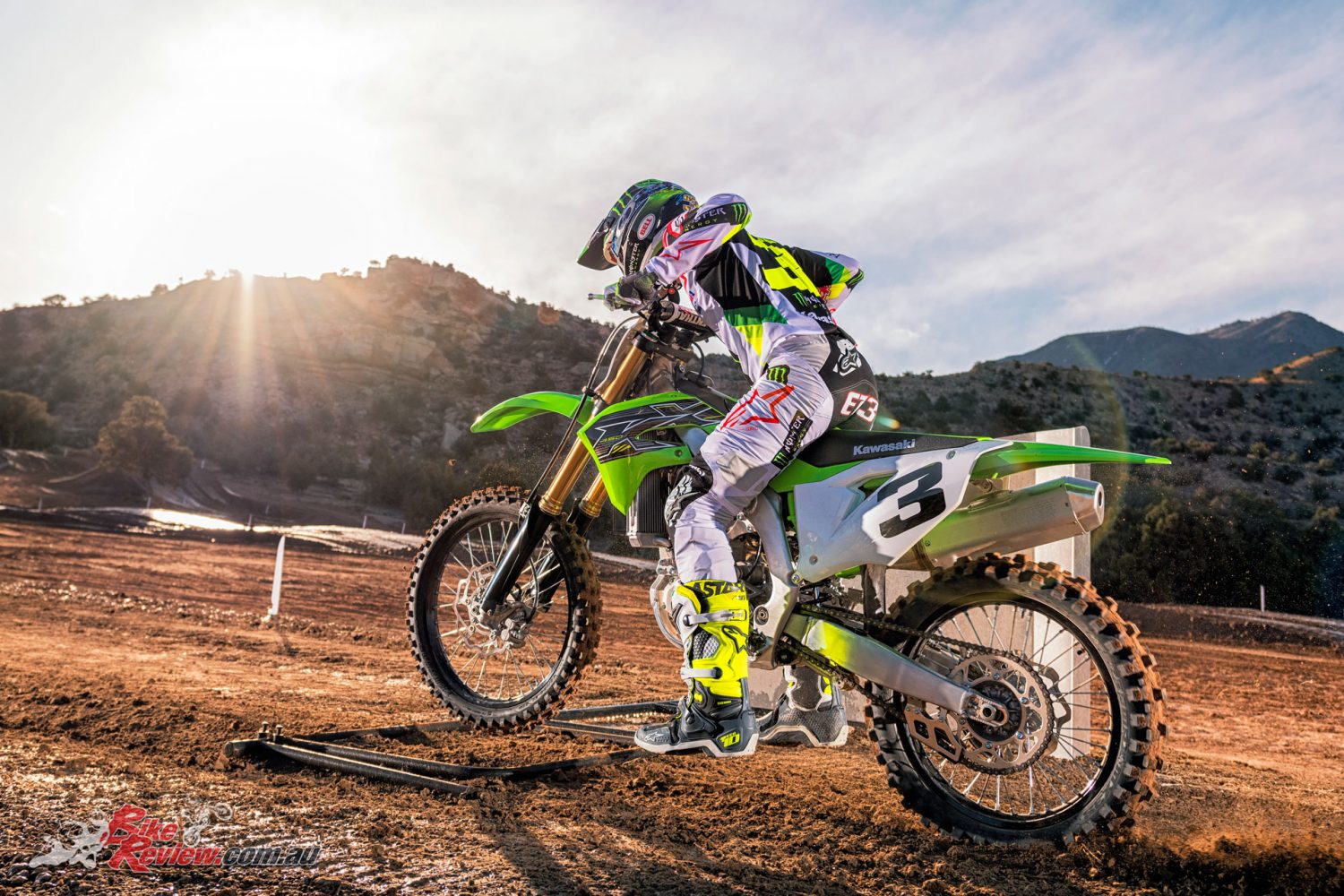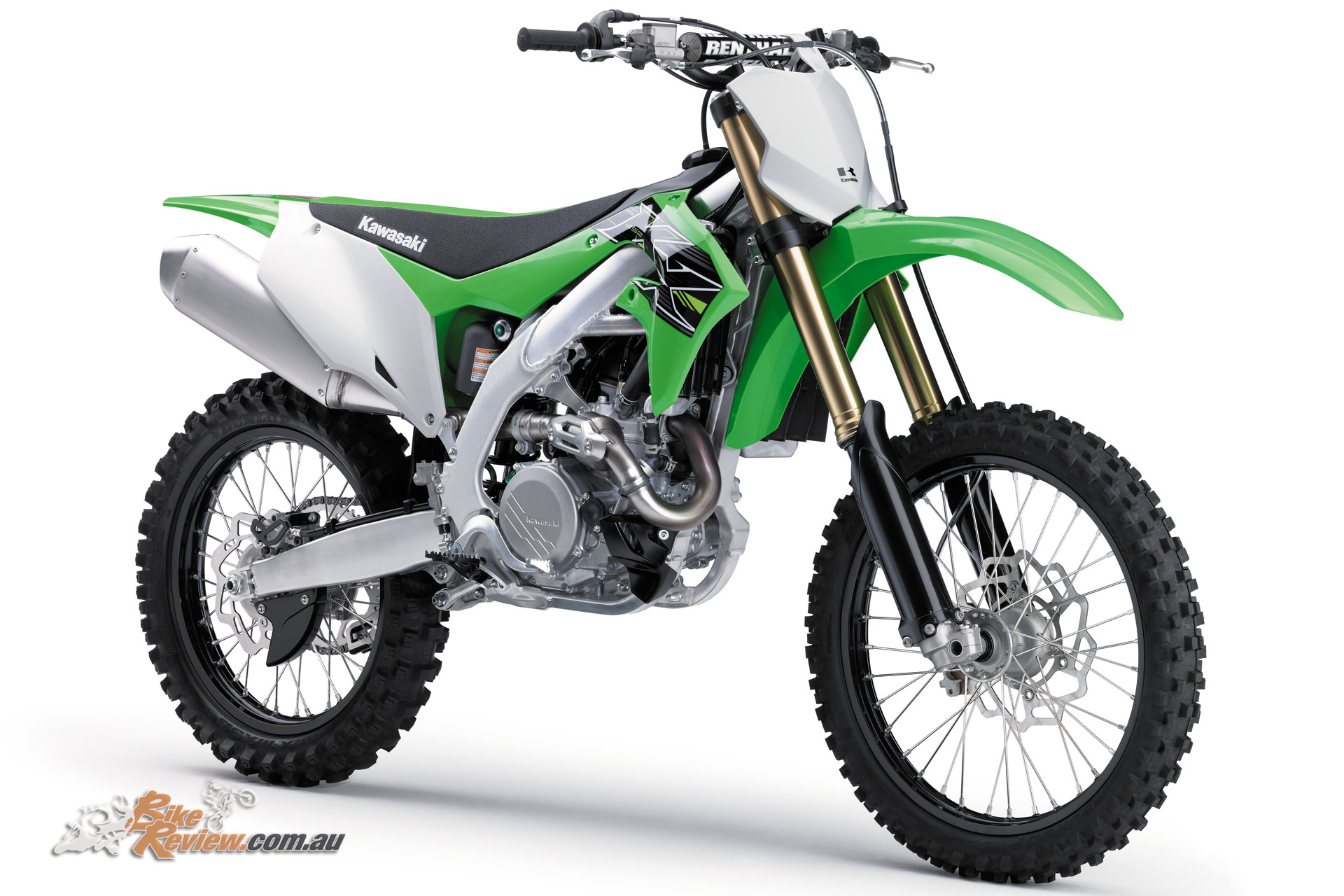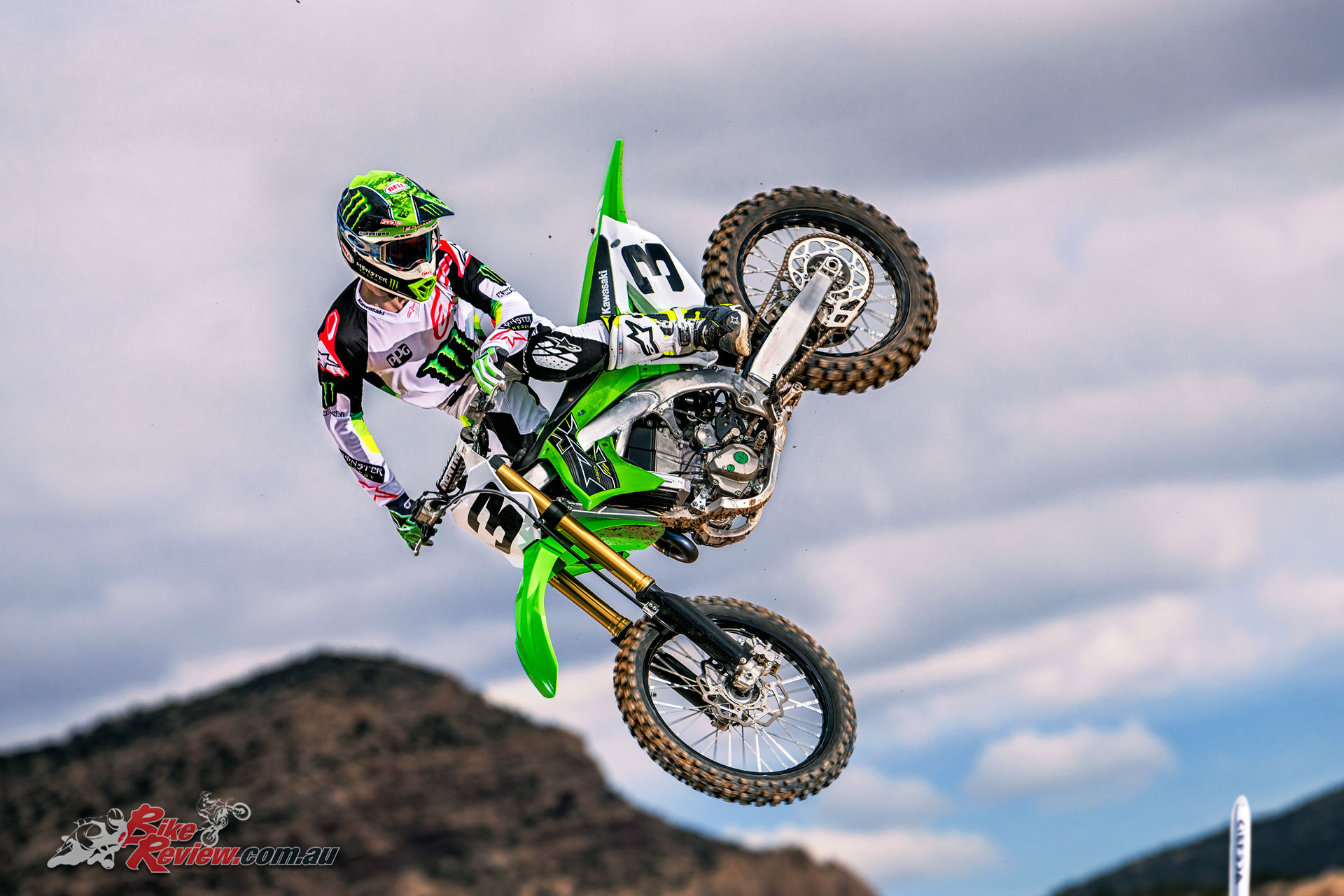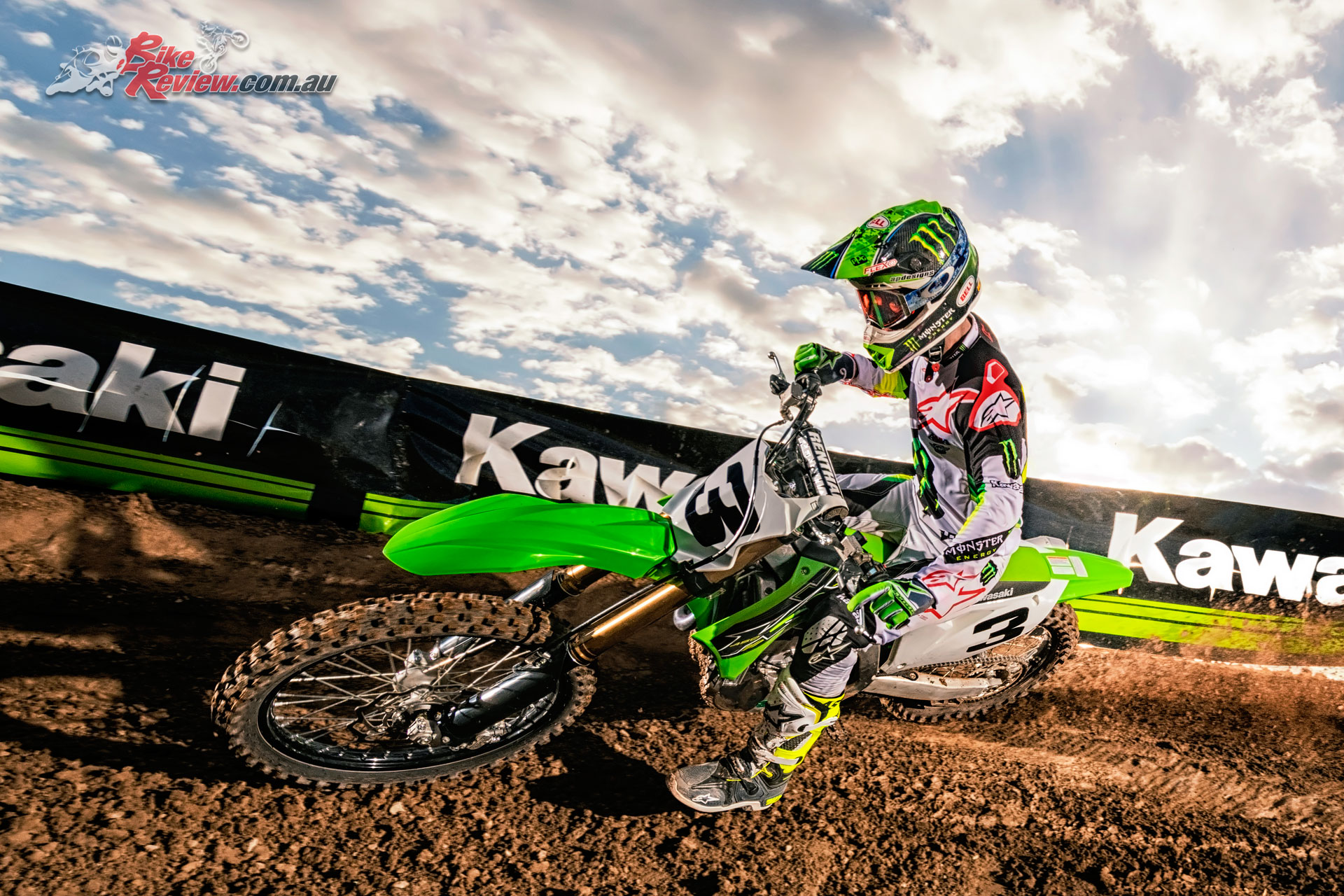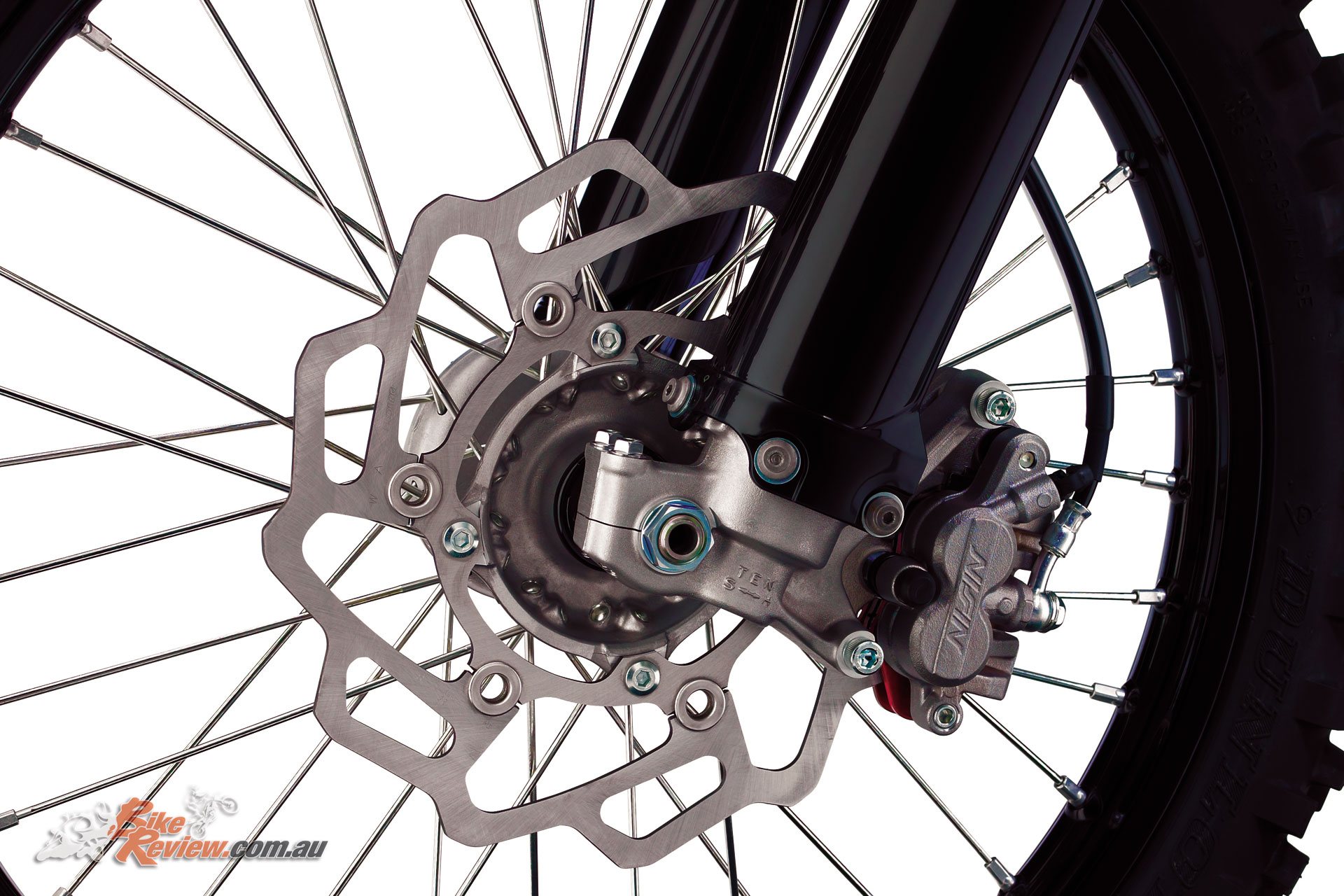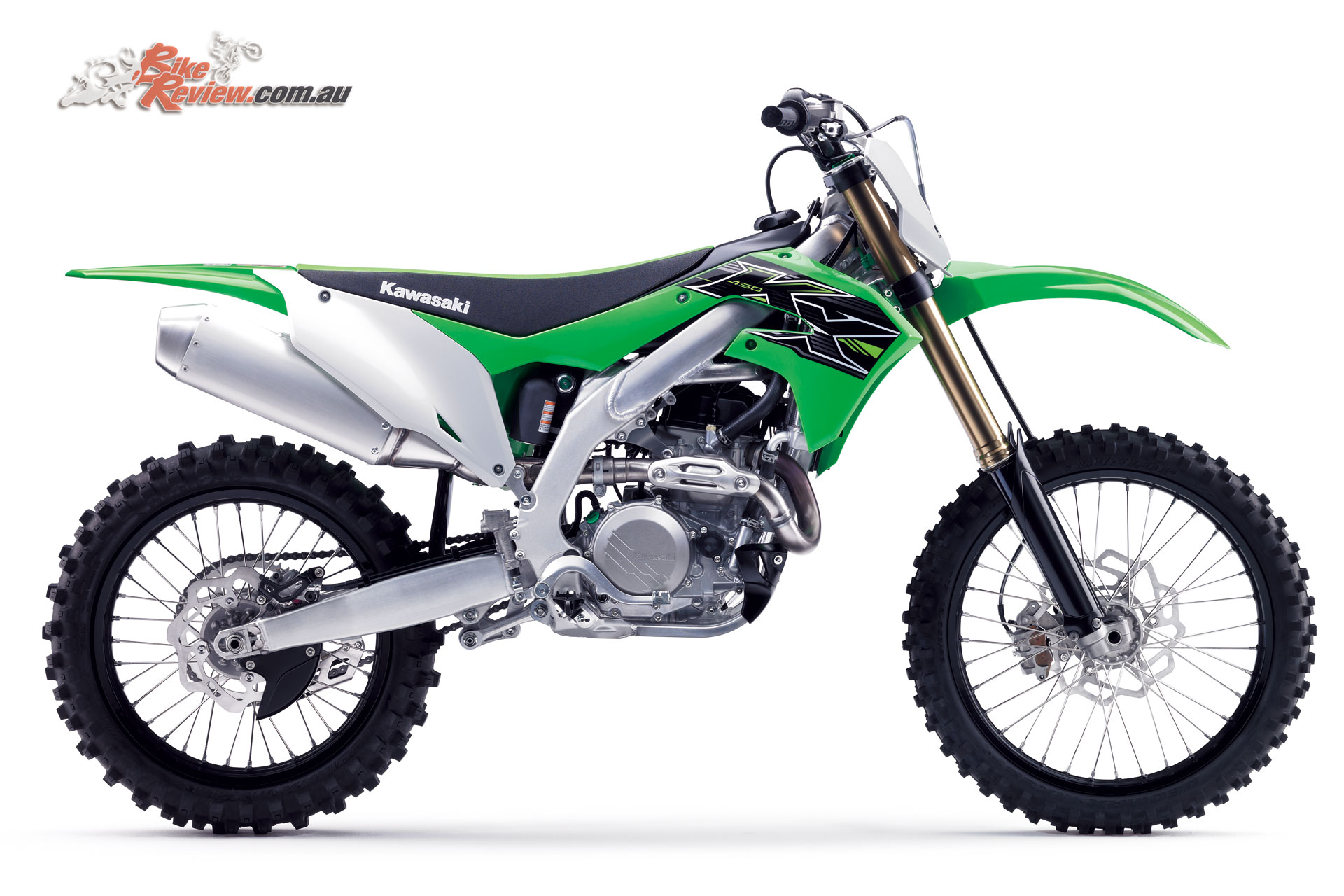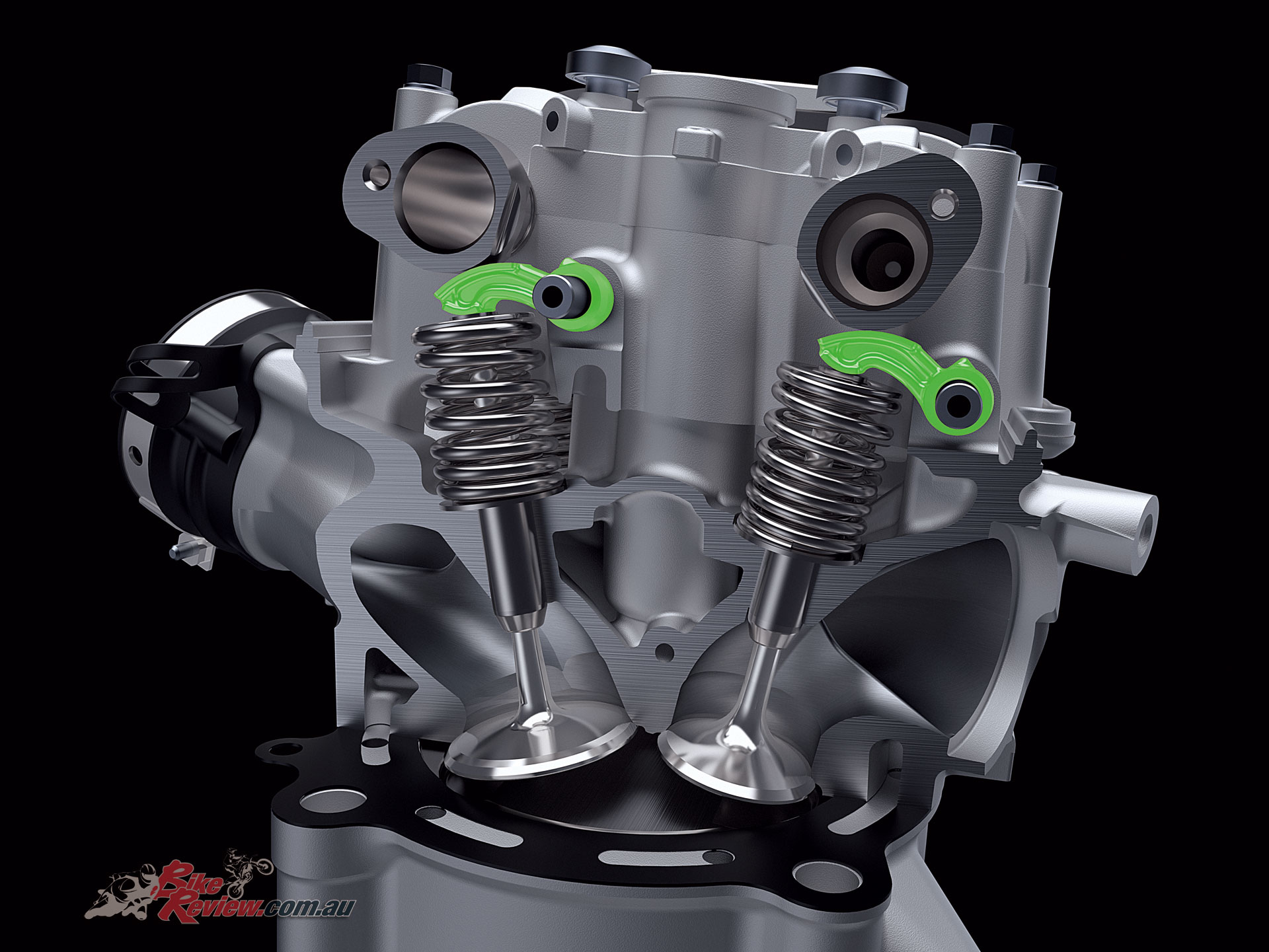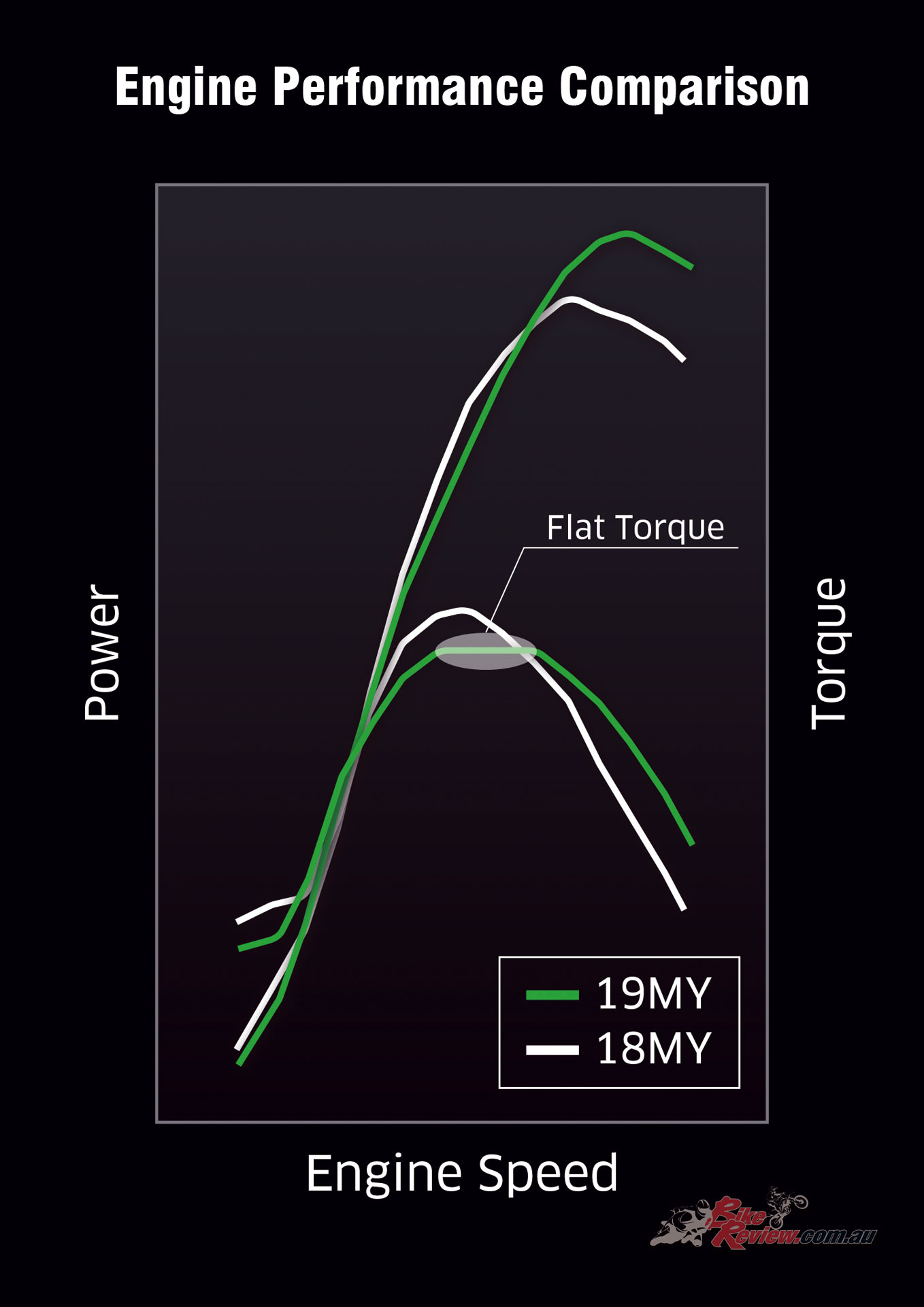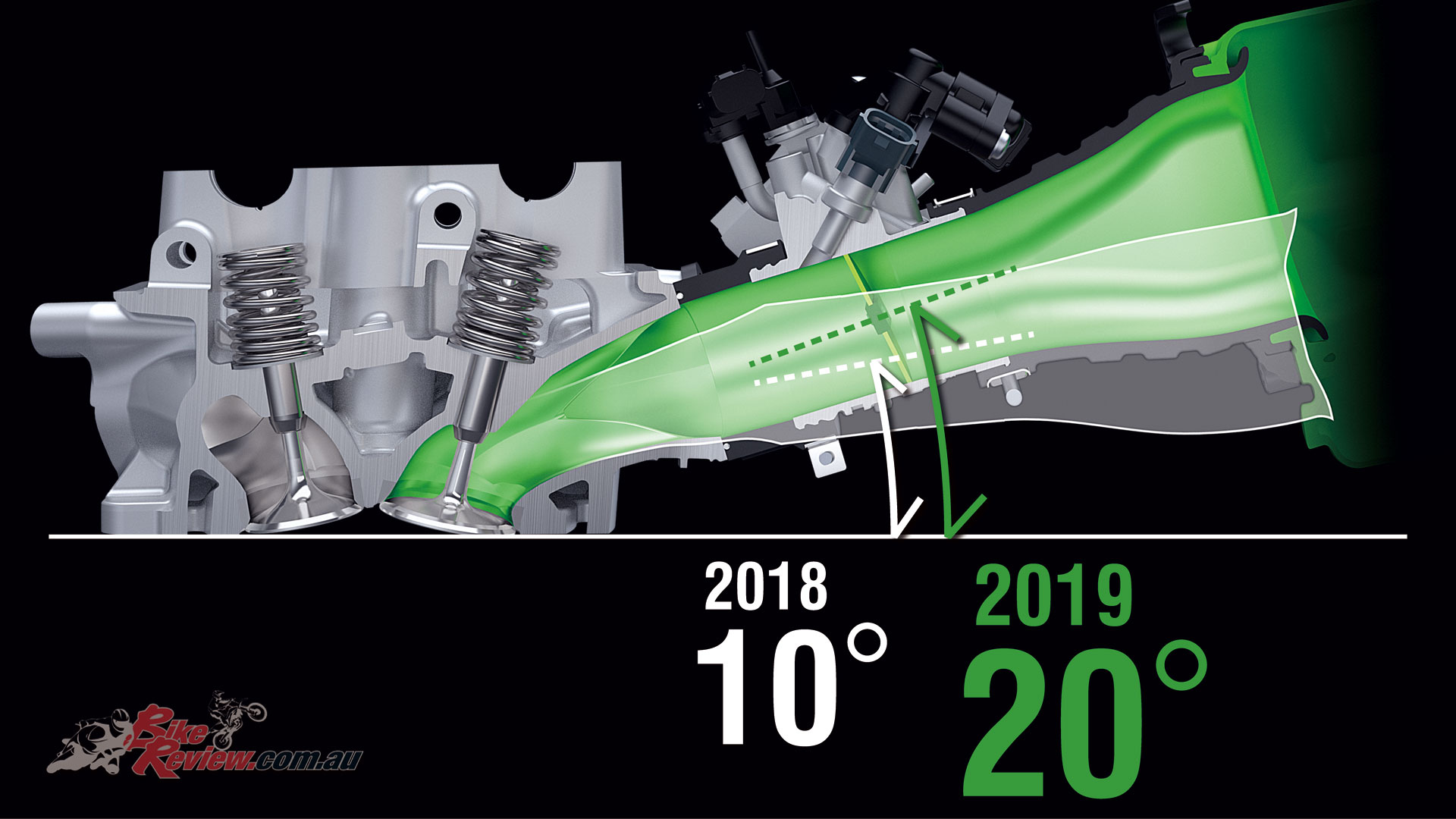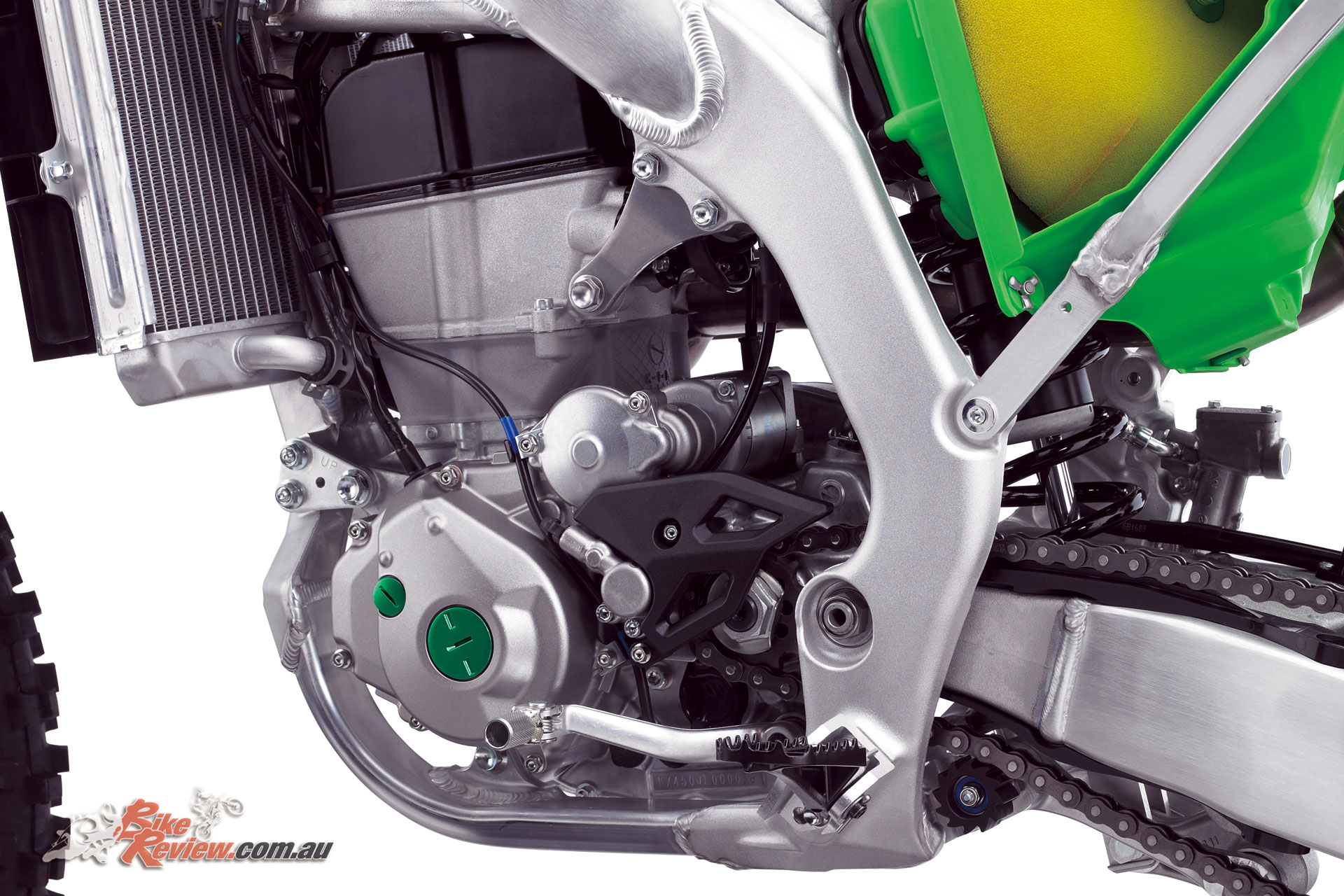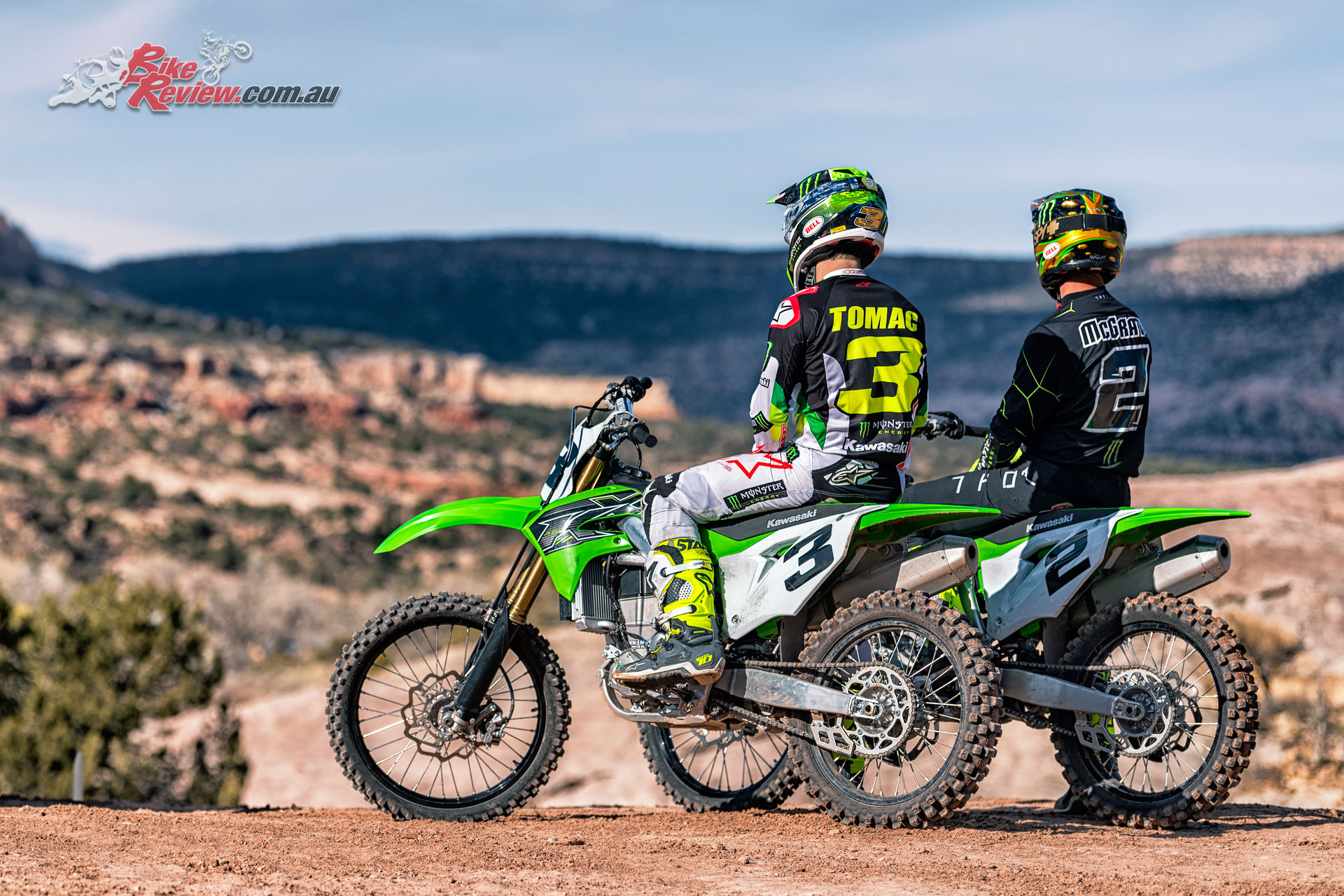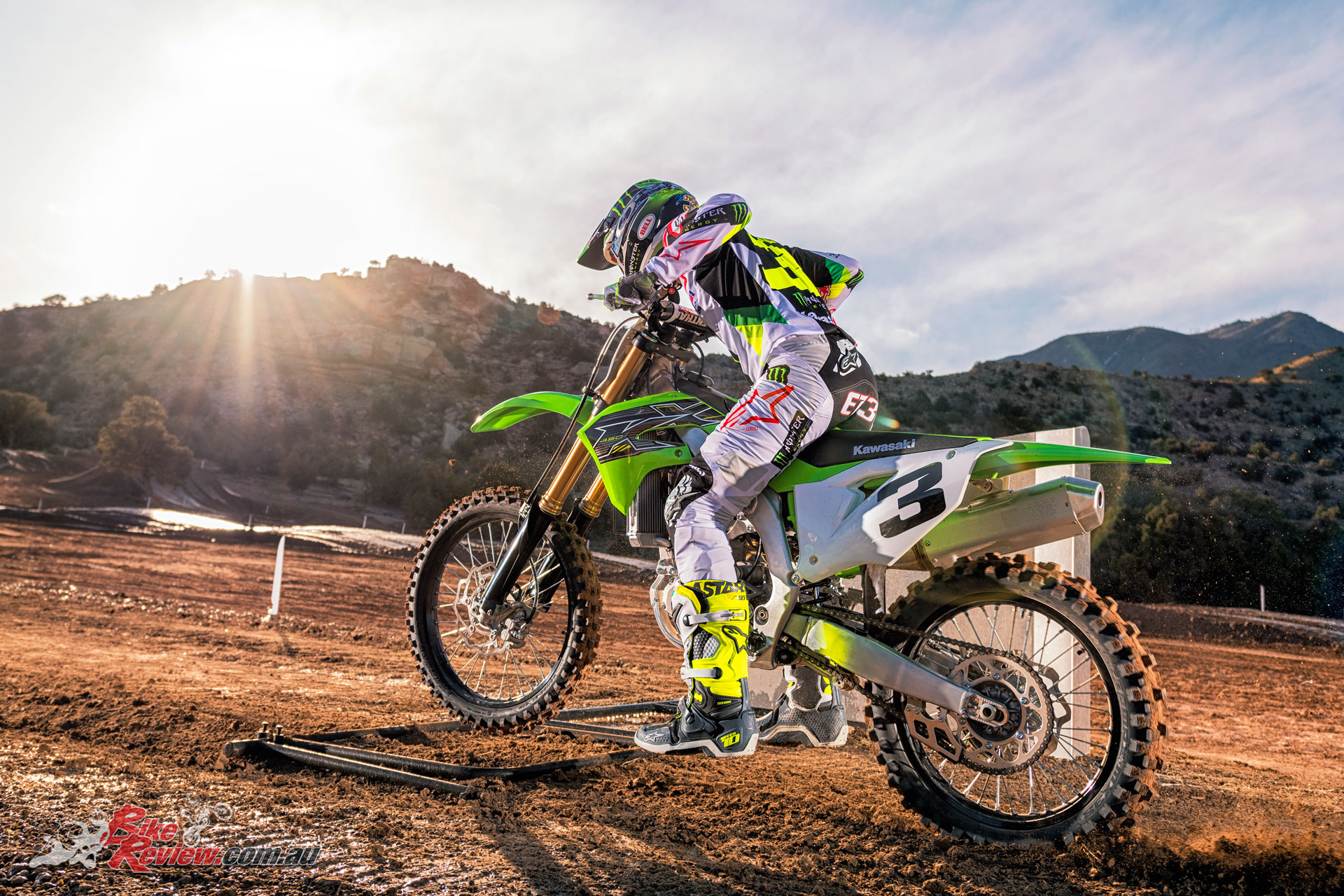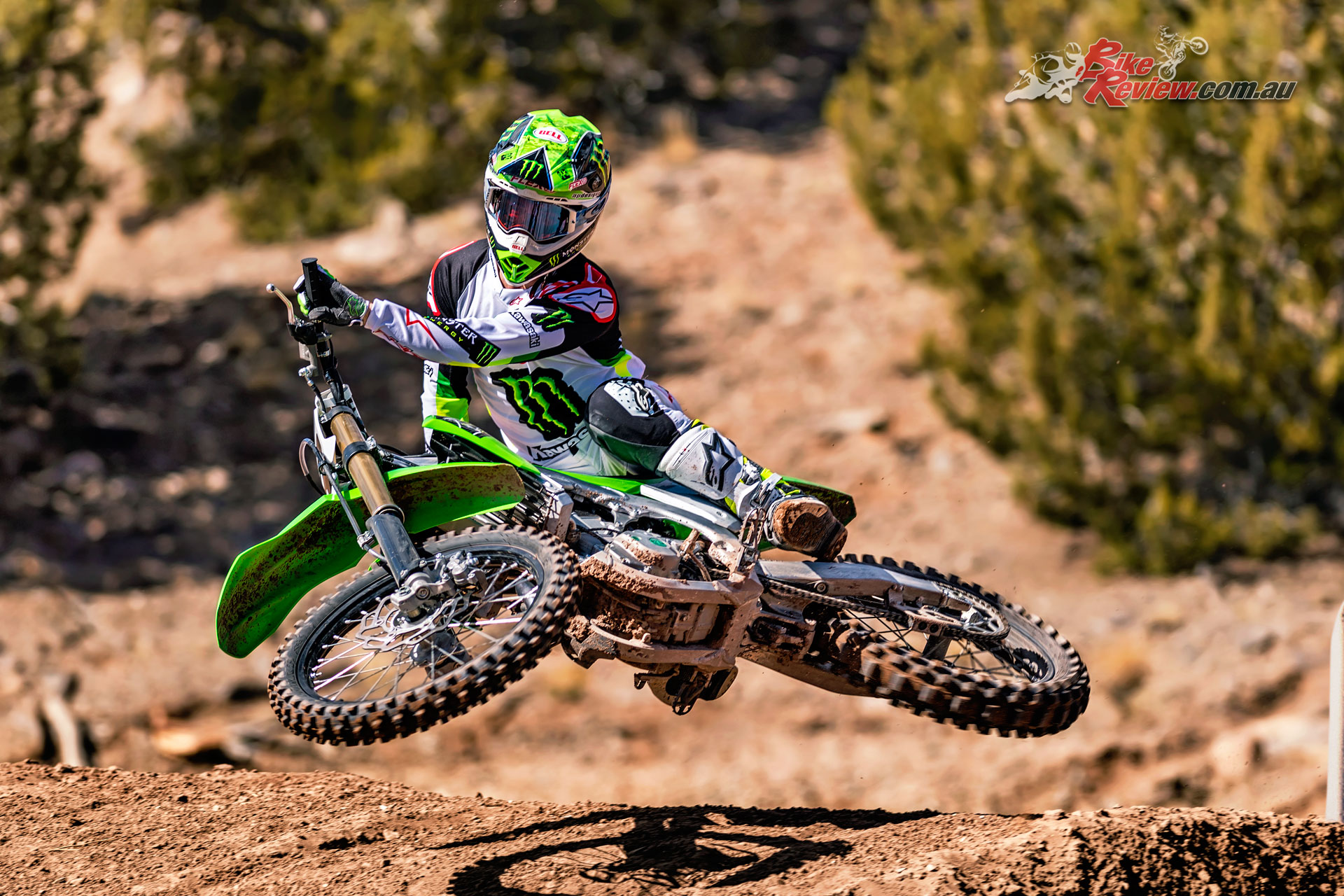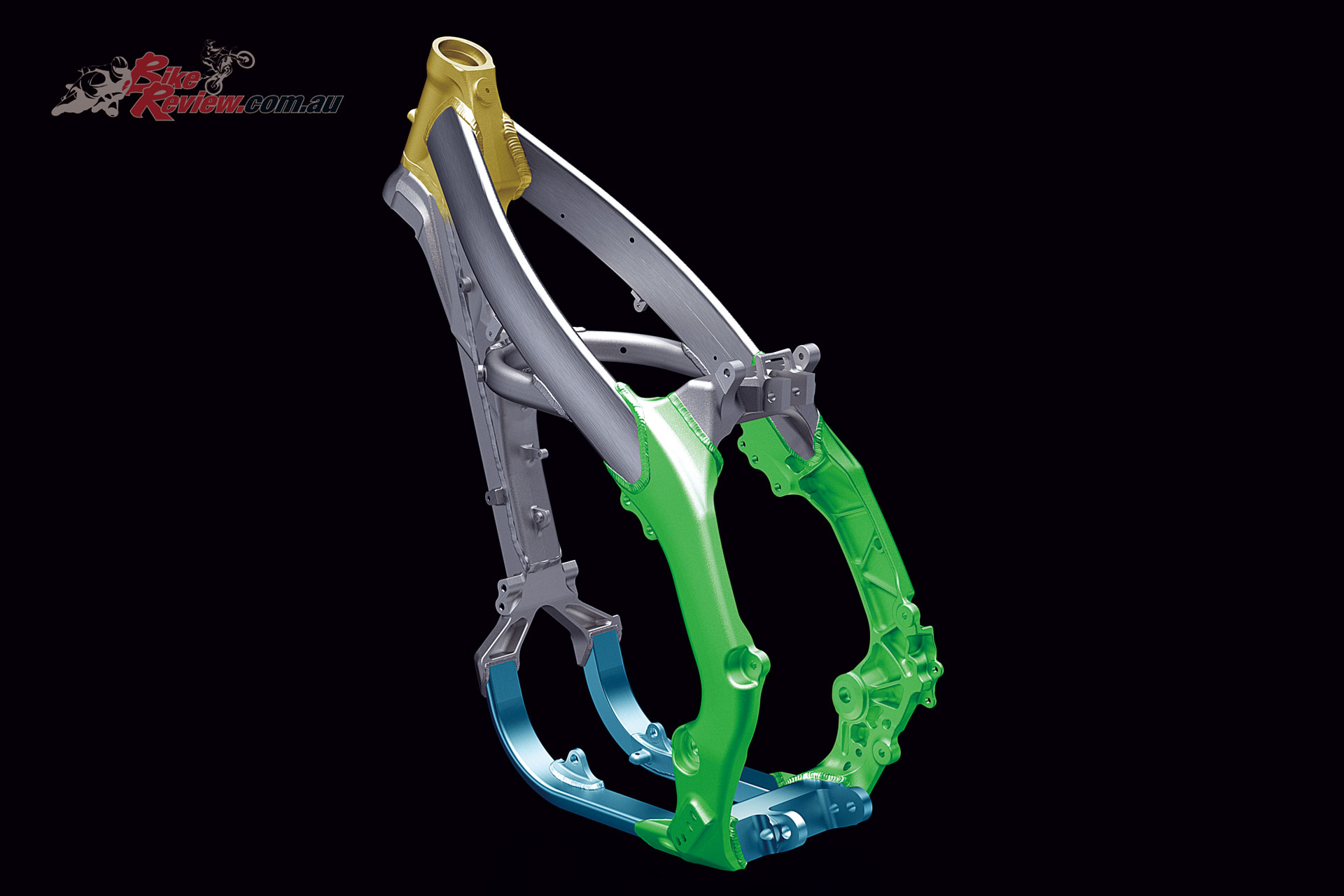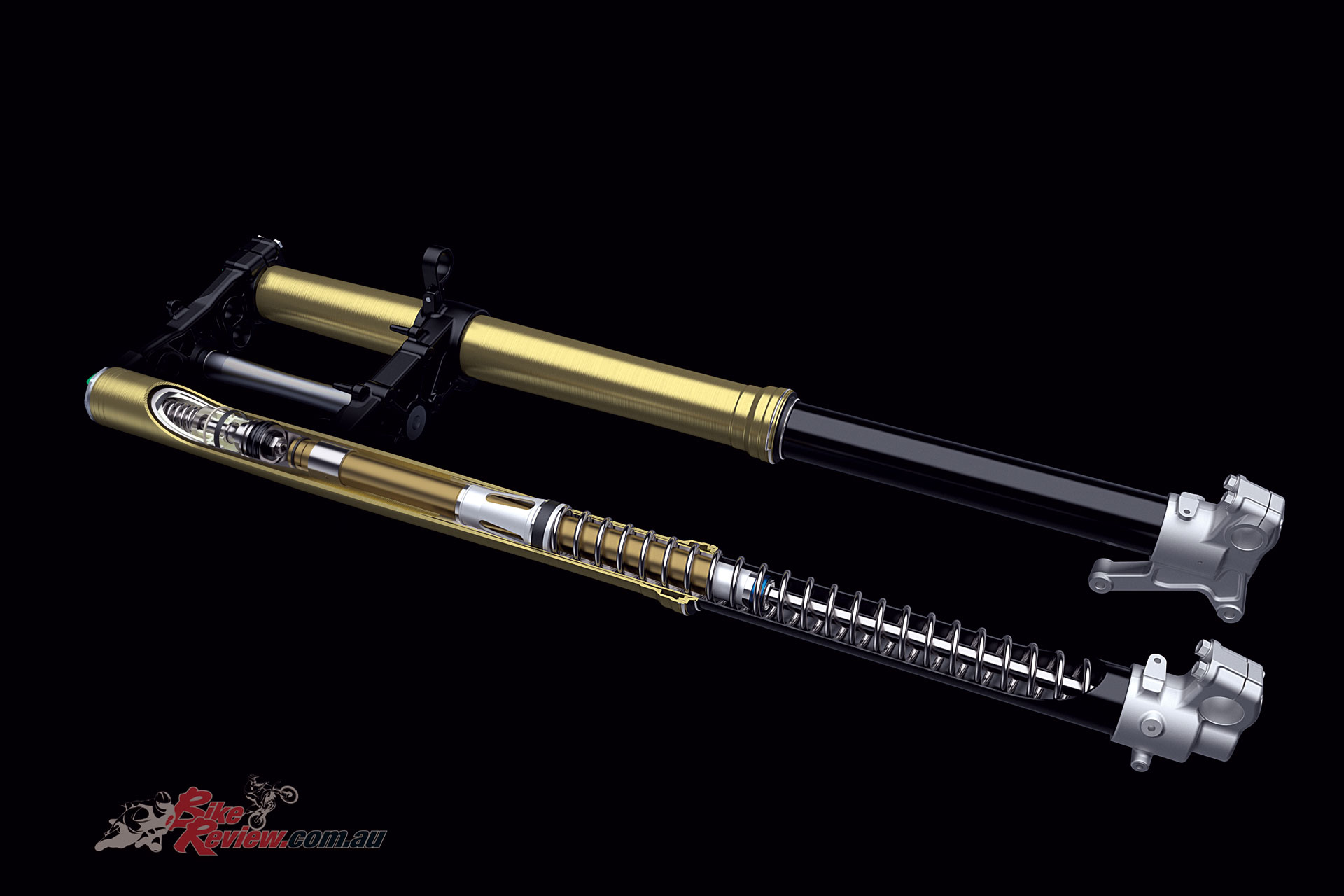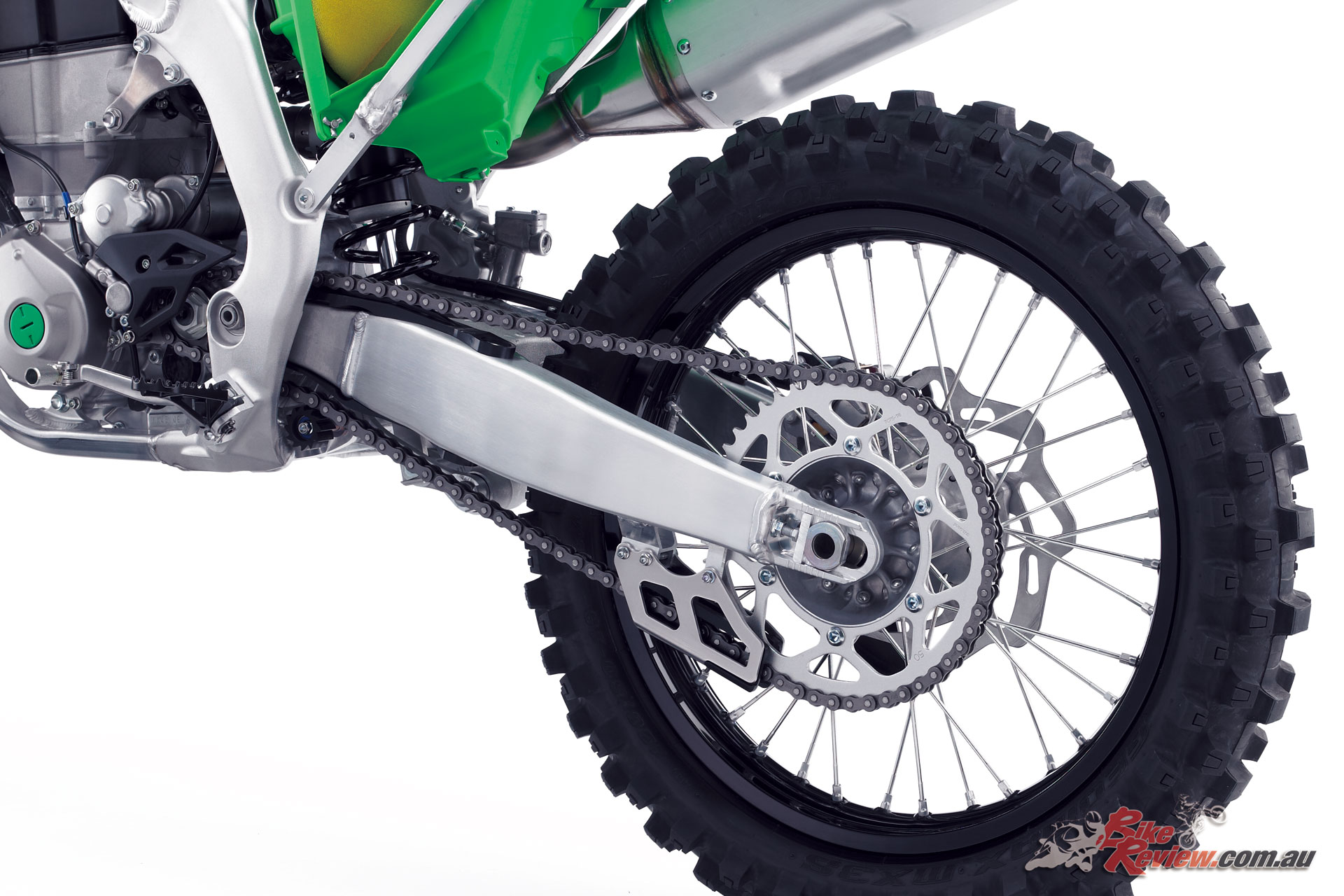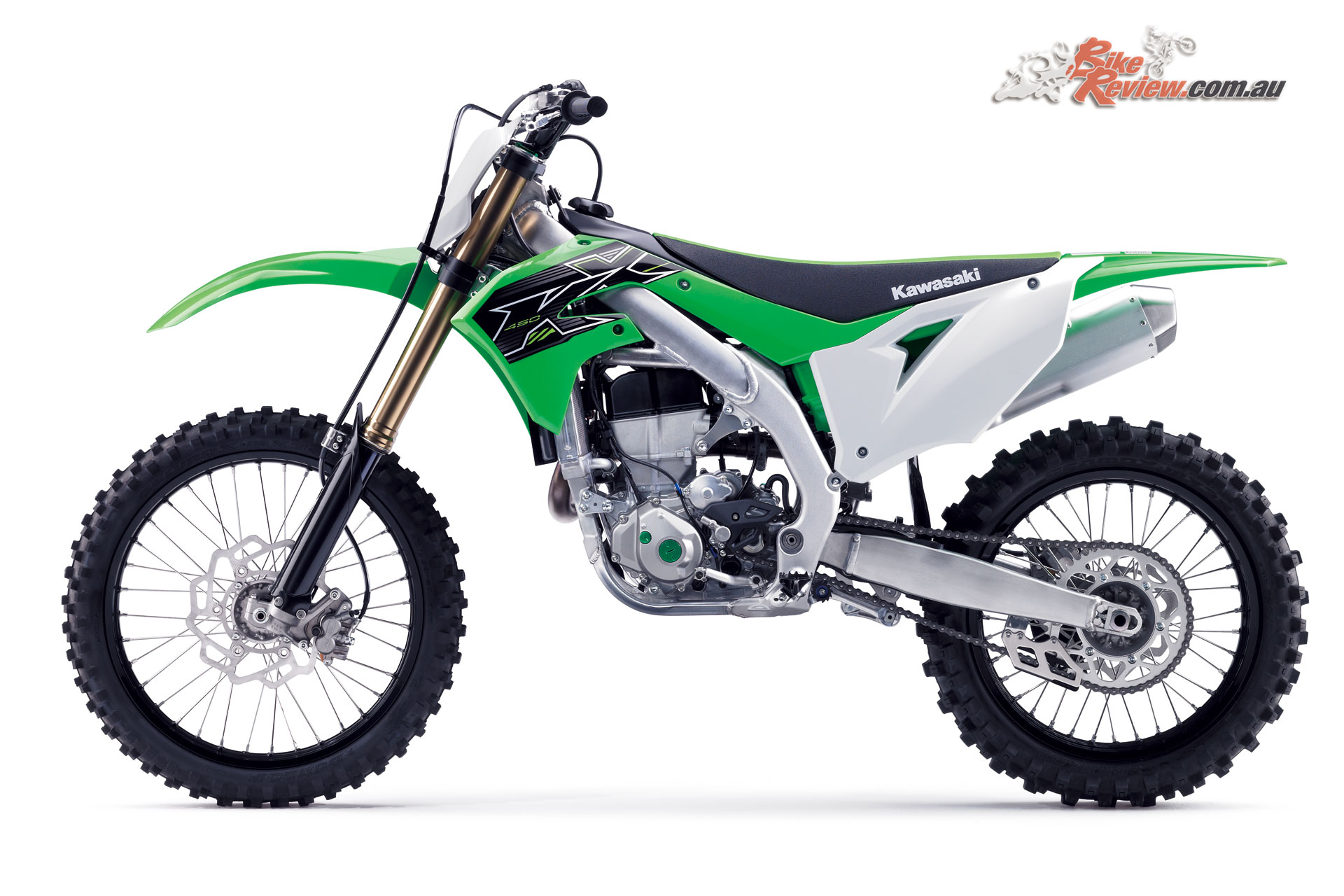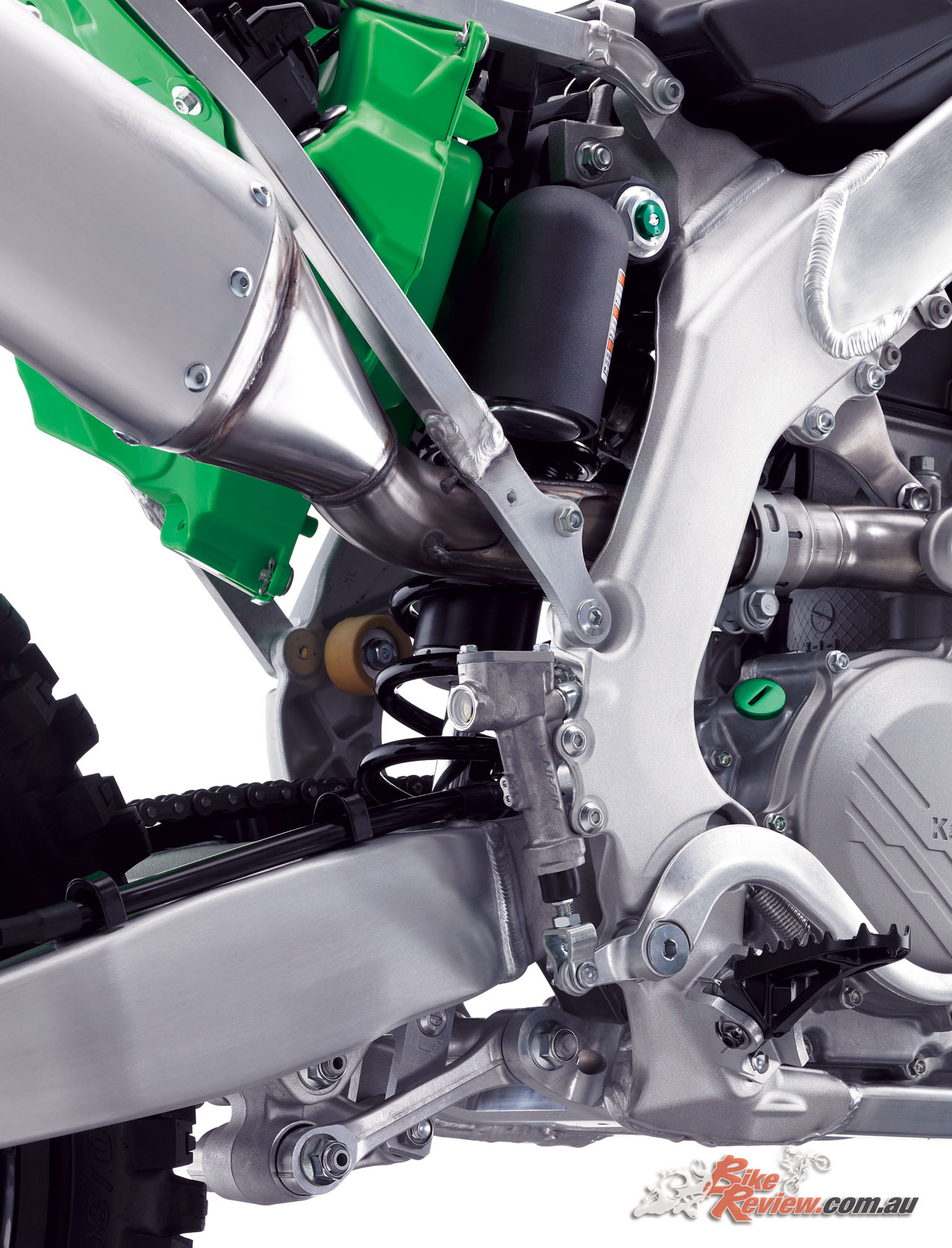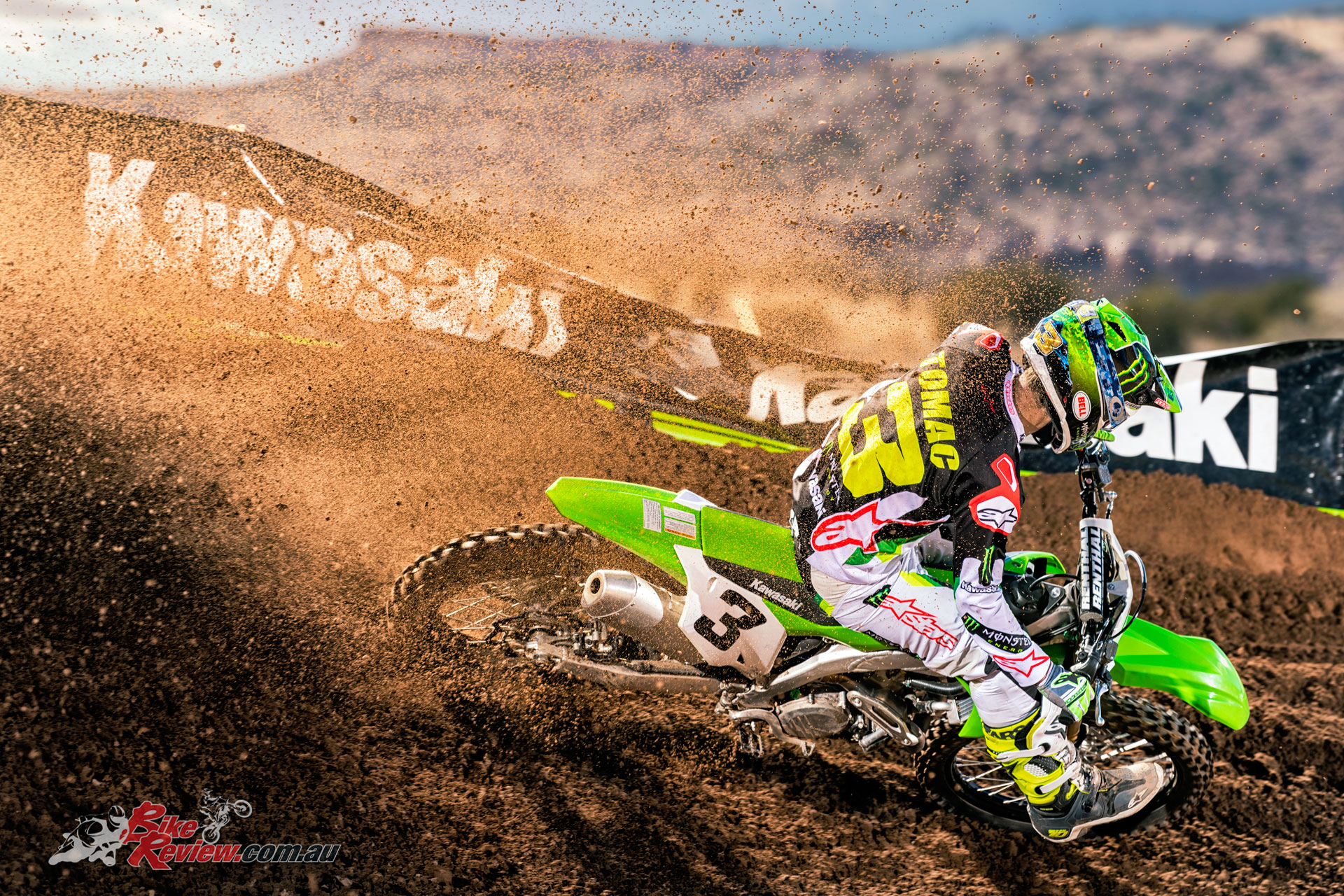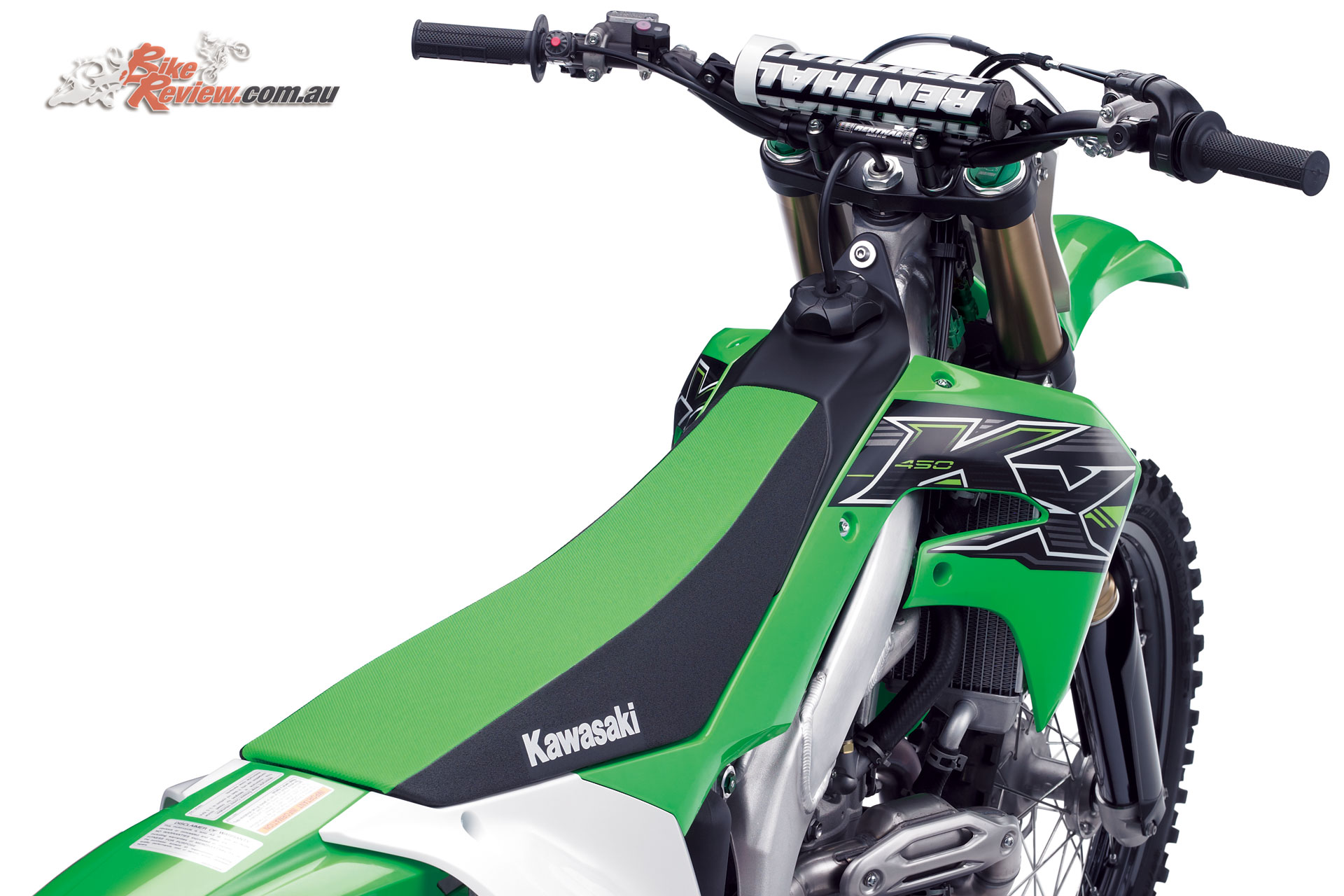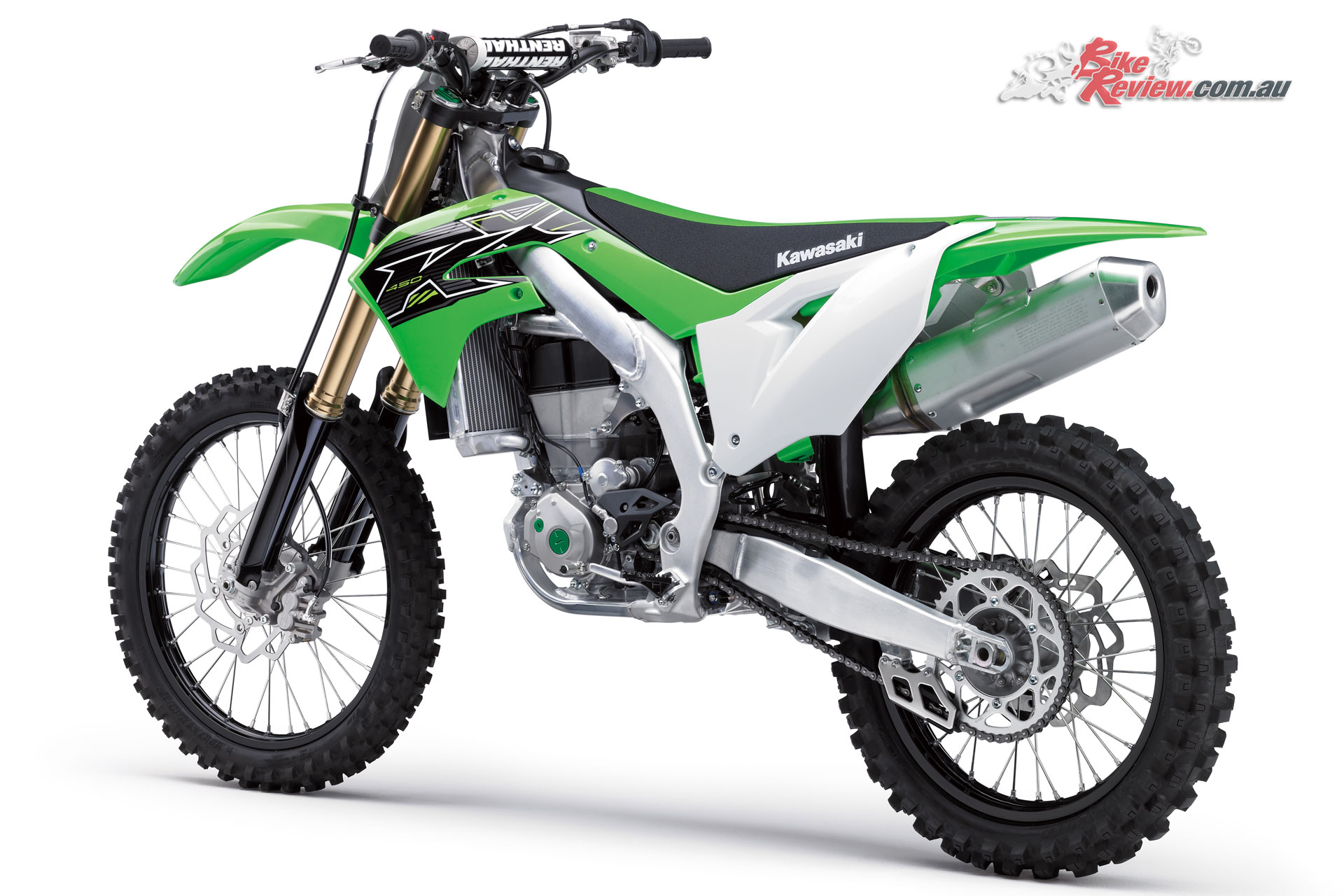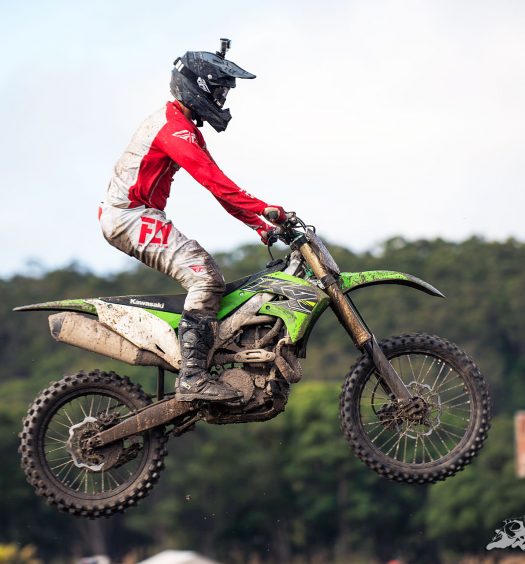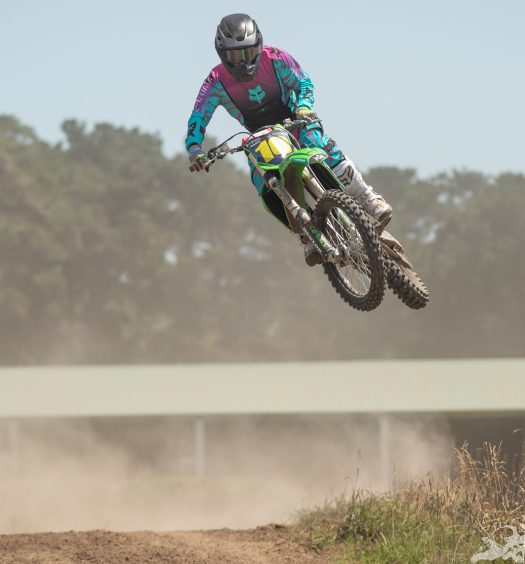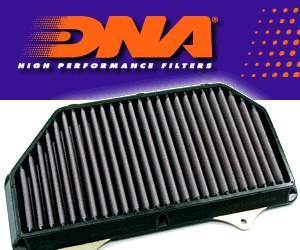Kawasaki announce the 2019 KX450F, boasting a huge number of updates and improvements, from the frame and engine through to bodywork and electronics...
Designed with mid-level to expert riders in mind, the KX450 motorcycle has always been built with one goal: to put riders on the top step of the podium. And for over 40 years KX motocrossers have been extremely successful.
To maintain its edge in this competitive class, the 2019 KX450 benefits from a new engine mounted in its leanest chassis to date, enabling it to turn even quicker lap times, and make it the most powerful machine in the paddock.
Complementing already high performance, a number of new features – including finger-follower valve actuation, electric start and a hydraulic clutch, which are all firsts for a Kawasaki motocrosser.
Trimmed of all unnecessary material, this is the leanest KX450 chassis to date. Frame, suspension, brakes and ergonomics have all been improved, making the new KX450 even better equipped to turn quicker lap times.
The new engine boasts an increase in peak power of approximately 2.5 kW (3.4 PS), while a flatter torque curve makes it easier to get on the gas. Finger-follower valve actuation (a valve train designed by Kawasaki’s MotoGP & World Superbike engineers) enables larger-diameter valves and more aggressive cams. Downdraft-style intake and reduced friction loss (care of new plain bearings for the connecting rod big-end) further contribute to the power gains.
A factory-style launch control system increases the chance of getting a good start by helping riders maximise traction when starting on a slippery surface, while easy engine tuning is via a DFI Setting Data Selection system. Using the provided DFI couplers, riders can quickly and easily access their choice of three maps (standard, hard, soft) provided in the ECU.
A KX FI Calibration Controller accessory is also available and is a portable handheld calibration tool, which enables riders to make changes to engine maps by plugging into the ECU without needing a PC or battery. It comes equipped with seven preset map settings.
An evolution of the current design, the new frame features revised rigidity and includes the engine as a stressed member. A new swingarm also contributes to the revised rigidity balance and increased rear traction.
Complementing the powerful engine, light, nimble handling contributes to the KX450’s quick lap times. While the addition of electric start and the return to a coil-spring fork add weight, efforts were made to keep the weight gain to a minimum. The result is the KX450’s low overall weight of only 110.0 kg – a gain of only 1.3kg.
Matching the KX450’s increased power, increased front and rear traction ensure the bike can put power to the ground and get around corners quickly. A larger-diameter front axle (a hint from our racing teams) helps at the front, while revised rear suspension layout and new linkage ratios benefit the rear.
Handling suspension duties up front is a new high-performance 49mm inverted coil-spring fork. The large-diameter inner tubes (the same size as on our factory racers) enables the use of large damping pistons, delivering smooth action and firm damping.
A larger-diameter φ250 mm rear disc complements the oversized φ270 mm front disc, delivering stronger stopping power. A new front brake master cylinder offers better initial control, while contributing to overall braking performance.
All-new bodywork (except the front fender and number plate) was designed to facilitate rider movement. Long, smooth surfaces make it easy to slide back and forth. The tank is lower and flatter, making it easier to sit farther forward. Slimmer shrouds are easier to hold on to. Even the engine covers are smooth so that they do not impede rider movement.
A choice of four handlebar positions and two footpeg positions allows riders to tailor their riding position to suit body size and preference.
2019 Kawasaki KX450F Tech Talk
ENGINE
The hard-hitting fuel-injected 449cc liquid-cooled, four-stroke single with factory-racer engine tuning now boasts an increase in peak power of approximately 2.5 kW (3.4 PS), while a flatter torque curve makes it easier to get on the gas.
Finger-follower valve actuation (a valve train designed by Kawasaki’s MotoGP & World Superbike engineers) enables larger-diameter valves and more aggressive cams. Downdraft-style intake and reduced friction loss (care of new plain bearings for the connecting rod big-end) further contribute to the power gains.
A new valve train designed by Kawasaki’s MotoGP & World Superbike engineers bring top-level road-racing technology to the KX450. It uses finger-follower valve actuation, enabling larger-diameter valves and more aggressive cam The change to finger-follower valve actuation reduces the valve train mass (IN is 4.2% lighter; EX is 7.9% lighter) compared to a tappet-style valve actuation (even taking into account larger-diameter valves). NDLC (Diamond-Like Carbon) coating on the finger followers helps protect against wear.
Complementing more aggressive cams, larger-diameter intake (φ36 mm >> φ40 mm) and exhaust valves (φ31 mm >> φ33 mm) with increased lift (IN: 9.8 mm >> 11.0 mm; EX: 9.0 mm >> 9.5 mm) flow more air, contributing to the increased power. The camshafts benefit from a thin and highly durable gas soft-nitriding treatment for long wear and high-rpm reliability.
Valves are formed from lightweight titanium, reducing reciprocating weight and offering high-rpm reliability. SCr (chromium steel) valve spring retainers contribute to increased reliability at high-rpm.
A new high-performance piston, featuring the same design used on our factory racers, contributes to strong performance at all rpm. A short skirt, reinforced external ribs and the use of a bridged-box bottom, featuring internal bracing, contributes to a light, strong piston design. Revised design and strength optimisation results in an even lighter piston (259.8 g >> 243 g), further reducing reciprocating weight and contributing to the engine’s increased performance.
A change from needle bearings to plain bearings for the connecting rod big-end reduces mechanical loss, contributing to overall performance.
The engine is almost upright (forward lean angle is 3°) to help place the bike’s centre of gravity in the ideal position for maximum traction, while the cylinder is offset (8.5 mm forward), reducing friction and enabling more efficient power generation.
ECU settings include programming that enhances traction by retarding ignition when the rear wheel speed increases too quickly (i.e. from sudden, excess wheel spin).
Thinner air cleaner element restricts airflow less, contributing to increased performance at all rpm, and downdraft-style intake routing allows an even straighter approach for intake air. The intake air’s approach angle into the cylinder increases from 10º to 20º, improving cylinder-filling efficiency and contributing to increased engine power.
A new larger-diameter (43mm >> 44mm) throttle with reversed orientation – it turns in the opposite direction to open – flows a greater volume of air, contributing to increased performance – especially high rpm and over-run – and driveability. Fine-atomising injector with 12 holes sprays particles with a droplet size of 75 μm (previously 60 μm) and flows over 20 per cent more fuel (391.7cc >> 478.3cc), contributing to the engine’s increased power. The fine droplet size contributes to smooth power delivery and superb engine response at partial throttle.
A lightweight flat-bottom aluminium fuel pump is located in the plastic fuel tank, and revised fuel pump design is more compact, enabling a flatter design for the top of the tank.
During the cylinder head casting process, the cores for the intake ports were given a special coating to make the intake ports smoother. The extremely smooth surfaces that result increase intake efficiency at all rpm.
Longer header pipe (590mm >> 695mm) contributes to increased low-end power. Kawasaki’s first hydraulic clutch on a motocrosser offers more direct feel and lighter lever action. Less play as the clutch heats up during heavy use results in more consistent feeling.
The combination of the smooth-shifting, close-ratio 5-speed transmission with the KX450’s low-rpm engine performance offers the rider the option to shift to a higher gear when traversing rough sections. This reduces the effect of sudden (unwanted) throttle input, allowing focus to be given to racing rather than careful throttle control. Revisions to the change drum and shift fork save 15g in weight.
ELECTRONICS
Being able to restart an engine quickly during a race can mean the difference between keeping your lead, or having to fight your way back through the pack. Kawasaki’s first electric start on a motocrosser makes restarting the engine as easy as pushing a button. Starting is electric only, via a button located at the right grip and a lightweight, compact Li-ion battery helps keep weight gain to a minimum.
KX250-style automatic centrifugal decompression system fitted to the exhaust cam lifts one exhaust valve to facilitate starting. The system’s simple construction ensures light weight and high reliability.
Launch Control Mode is just one of the factory features that give riders an edge when lining up at the start gate. The KX450 features a launch control system similar to that on the factory racers. With the simple press of a button, riders can activate a separate engine map designed to ensure efficient race starts in slippery conditions. (The Launch Control Mode map retards ignition timing, allowing tyres to gain grip in low-traction situations, and allowing riders to focus on their lines.)
Launch Control Mode has the greatest effect within the first few seconds of releasing the clutch off the start. Even for top-level riders, controlling the power of a 450cc-class motocrosser off the start requires a high degree of throttle control and clutch finesse. By slightly reducing this power, Launch Control Mode helps riders maximise traction, increasing the chance of getting a good start.
To activate Launch Control Mode riders depress the launch control button (for two seconds or more), located at the left handle. Launch Control Mode works in 1st and 2nd gear (and Neutral). Once the rider shifts into 3rd gear, the system is automatically disengaged, switching back to the normal engine map. The system designed to the same specifications as that of our AMA factory racers.
Adjusting engine settings to suit conditions has never been easier than with the KX’s DFI couplers, a plug-and-play style system that is quick, easy and stress-free. Instead of a single engine map, the ECU features three (four, counting the Launch Control Mode map). Initial settings for the three maps are: Standard, Hard (conditions) and Soft (conditions). Using provided DFI couplers, riders are able to easily switch between the three maps to suit riding conditions.
Plugging in each of the 4-pin couplers activates the corresponding engine map. (Plug is conveniently located on the right side of the head pipe for easy access without having to remove any parts.) Maps can now be changed while the engine is running, which is a new feature. Each of the three maps can be reprogrammed using the optional KX FI Calibration Kit. (Please see below.)
KX FI Calibration Kit (Accessory)
The KX FI Calibration Controller is a handheld tool with a built-in colour LCD screen. It comes with transfer and diagnostic cables, SD memory card, user manual and a carrying case. While the controller is designed to satisfy racers and expert riders, it is simple and hassle-free to use.
Accessing the ECU is accomplished simply by connecting the controller using the provided cables (no PC or battery necessary). The kit’s user-interface is simple to understand and easy to use. Maps can be stored on a PC: data transfer between the controller and a PC can be done via SD card
The KX FI Calibration Controller contains seven preset map settings that can be quickly and easily used to adjust the ECU to suit track conditions. The provided settings are shown below.
- Richer fuel setting fuelling 5% richer than stock
- Leaner fuel setting fuelling 5% leaner than stock
- Advanced ignition setting ignition advanced 3o from stock
- Retarded ignition setting ignition retarded 3o from stock
- Hard riding surface setting ignition retarded, fuelling richer
- Soft riding surface setting ignition advanced, fuelling leaner
- Low-power setting engine power suppressed: ignition retarded, fuelling richer
For more advanced setting optimisation, the ECU maps for volume of fuel injected and ignition timing can be adjusted for given throttle position and rpm. When connected to the ECU, the KX FI Calibration Controller can be used to display the status of a running engine.
KX FI Calibration Controller can be used with older fuel-injected KX models (2015 and earlier). For more detailed information on use and functions of the KX FI Calibration Controller, refer to the KX FI Calibration Controller User Manual.
CHASSIS
Slim aluminium perimeter frame is a lightweight construction composed of forged, extruded and cast parts. An evolution of the current design, the new frame offers a better overall rigidity balance, and the engine is used as a stressed member, contributing to the frame’s rigidity balance.
Steering head area with optimised rigidity, main frame rails with revised cross-sections, and a revised line for the swingarm brackets contribute to the overall rigidity balance. Wider lower frame rails also contribute to overall rigidity balance.
Swingarm rigidity was also revised to match the frame, and contributes to increased rear traction, and chassis balance and settings were all set to suit race-experienced riders. The centre of gravity and key dimensions (swingarm pivot, output sprocket and rear axle locations) were chosen so that the rear tyre would drive the bike forward (instead of causing it to squat).
New high-performance 49mm inverted coil-spring fork handles suspension duties up front, with large-diameter inner tubes (the same size as on the factory racers) that enable the use of large damping pistons, delivering smooth action and firm damping. A super-hard titanium coating on the outer surface of the fork inner tubes helps prevent wear abrasion. The increased surface hardness of the dark navy blue coating also helps to prevent scratches and damage to the tubes. Because the surface remains smooth for a longer period, sliding friction (and stiction) is reduced and action is improved, contributing to a smoother ride.
Kashima Coat creates a hard, low-friction surface on the outer tubes. The hard coating helps prevent wear abrasion on the inside of the tubes, ensuring the sliding surfaces remain smooth for a long time, while the outside is protected against corrosion. The lubricating material in the coat contributes to smoother suspension action (especially at the initial part of the stroke) and a better ride feel.
The New Uni-Trak rear suspension system mounts the suspension arm below the swingarm, allowing a longer rear suspension stroke. The longer stroke in turn allows more precise rear suspension tuning. Revised linkage ratios contribute to increased rear wheel traction. Shifting the shock 5mm to the right allows room for the new downdraft-style engine intake. Revised rear shock layout also contributes to increased rear wheel traction.
The rear shock features dual compression adjustability, allowing high-speed and low-speed damping to be tuned separately. A self-lubricating alumite coating on the tank cylinder helps prevent wear abrasion, and reduces friction for smoother suspension action.
Petal disc brakes are among the KX450’s numerous factory-style components. The stylish discs contribute to both sporty looks and a high-quality appearance. Oversized semi-floating φ270 mm front disc contributes to strong front brake force, as well as superb controllability.
Revised front brake master cylinder offers better initial control, while contributing to overall braking performance. A larger-diameter rear disc (240mm >> 250mm) matches the large front disc and contributes to stronger stopping power. Revised rear brake master cylinder and hose are lighter.
Based on feedback from the factory race teams, the KX450 now also features a larger-diameter front axle shaft (20mm >> 22mm), which contributes to greater front-end traction, along with new Dunlop tyres contributing to increased front and rear traction.
WEIGHT SAVINGS
Savings from the engine group (including intake and exhaust systems) amount to approximately 0.93 kg; savings from chassis components total approximately 0.85 kg. Some of the major contributing components include:
- Revised duct, air cleaner construction -390 g
- Revised decompressor construction -200 g
- Optimised crankshaft design, new connecting rod bearings -177 g
- Aluminium silencer cap -60 g
- Smaller camshaft bearings -40 g
- Smaller fuel pump -34 g
- Rubber cooling system fittings -30 g
- New footpegs and aluminium brackets -260 g
- Main frame -140 g
- Change to aluminium brackets for electrical components -140 g
- New brake components (F/R) -100 g
- Hollow link bolts + aluminium collars -90 g
- Aluminium engine hangers -70 g
- Front engine mount (bolt >> stud) -50 g
ERGONOMICS
A smoother, flatter rider interface further improves the adjustable racer-friendly ergonomics, helping racers to ride even faster. A factory-style Renthal (standard-type) aluminium handlebar is standard equipment and the upper triple clamp with two sets of handle mount slots and reversible handle mounts offers riders a choice of four handle positions to choose from: 25 mm forward, 15 mm forward, STD and 10 mm back.
Bodywork is designed to facilitate rider movement features long, smooth surfaces that make it easy to slide back and forth. Seams between the shrouds, seat and side covers are very flush, which facilitates control as well as moving around on the bike.
Revised design for the top of the fuel tank top allows an even flatter progression from the seat to the tank. The flatter design gives the rider greater freedom of movement when changing riding position, and facilitates sitting farther forward. Slimmer shrouds are positioned closer to the frame. Designed to be slim where they come in contact with the rider’s legs, the new single-piece shrouds are easier to hold on to.
The seat uses a slip-resistant top surface for good grip when seated and smooth sides for excellent rider mobility. Seat urethane helps maintain the original shape longer.
The frame widens at the ankles to offer the rider better grip and narrows near the bend below the seat to allow a slim riding position. Smooth engine covers were also designed to not impede rider movement. Adjustable footpeg brackets enable riders to lower their footpeg position 5mm. In the lower position, centre of gravity is lowered as is the rider’s point of view and the revised footpeg design is 5mm wider (front-to-rear) and positioned 3mm rearward, offering excellent grip, superb feel, and making it easier to weight the pegs. The new design is also lighter.
BODYWORK & ACCESSORIES
Complementing the KX450’s sleek new bodywork, factory-style graphics ensure it is the sharpest looking bike in the paddock and further reflect the KX450’s highly tuned performance. Green highlights on the suspension adjusters and engine oil cap and generator cover plugs contribute to a distinctive Kawasaki look.
In-mould graphics used on the shrouds result in an ultra-smooth surface and ensure the racy graphics are not easily damaged. The aggressive design of the front fender adds to the racy looks, and rims are coated in black alumite – just like the factory racers. Fork and rear shock adjusters have a high-quality green alumite finish as well, with green finish on the oil cap and the two plugs on the generator cover further contributing to racy looks.
Optional chassis parts include handlebar holders for a 28.6 mm bar (STD: 22.2 mm), aluminium and steel rear sprockets (49-51T; STD: 50T), different springs for the rear shock (49, 51, 53, 55 N/mm; STD: 52 N/mm), plain shrouds (without graphics), and a skid plate.
The 2019 Kawasaki KX450F is available in Lime Green
2019 Kawasaki KX450F Specifications
Price: TBA
Colours: Lime Green
Claimed power: N/A
Claimed torque: N/A
Dry weight: 110kg
Fuel capacity: 6.2L
Engine: Liquid-cooled, 4-stroke Single, DOHC, four valves, 449cc, 96 x 62.1mm bore x stroke, 12.5:1 compression ratio, 44mm throttle-body, semi-dry sump, Digital DC-CDI ignition
Gearbox: Five speed, return
Clutch: Wet multi-disc
Chassis: Tubular, perimeter aluminium semi-double cradle
Rake: 27.6°, Trail: 122mm
Suspension: 49mm inverted fork, adjustable compression and rebound damping, Uni-Trak with adjustable dual-range (high/low-speed) compression damping, adjustable rebound damping and adjustable preload
Brakes: Single semi-floating 270mm petal rotor, dual-piston caliper, single 250mm rear petal rotor, single-piston caliper
Wheels & Tyres: 80/100-21 51M, 120/80-19 63M
Dimensions:
Overall length: 2185 mm
Overall width: 830 mm
Overall height: 1275 mm
Wheelbase: 1485 mm
Road clearance: 340 mm
Seat height: 955 mm
Curb mass: 110kg


